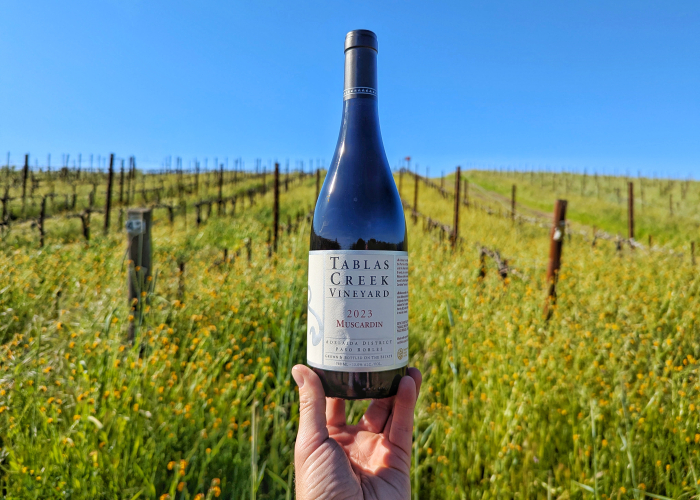Celebrating the bottling of Muscardin... and the completion of the Beaucastel Chateauneuf-du-Pape collection
I can feel my dad smiling down on Tablas Creek this week. On Thursday, we'll be hosting an industry event in which we'll be showing varietal bottlings of all fourteen of the Chateauneuf-du-Pape grapes that we imported from Beaucastel. We know that this will be a first in America. We believe it will be a first anywhere in the world. The featured attraction will be our 2023 Muscardin, which we bottled, all 21 cases strong, in April. This will be its debut appearance.

Back in 1989, when my dad, along with Jean-Pierre and Francois Perrin, decided on Paso Robles as the site of their homage to Chateauneuf-du-Pape, we initially focused on six Chateauneuf-du-Pape grapes: Mourvedre, Grenache, Syrah, Counoise, Roussanne, and Grenache Blanc (along with the Cotes du Rhone grapes Viognier and Marsanne). Of those, we had high expectations for Mourvedre, Grenache, Syrah, and Roussanne, and modest hopes for Counoise and Grenache Blanc. Those varieties were entered into quarantine in 1989, released in 1992, and planted here at Tablas Creek in 1994. It didn't take us long to decide we wanted a more complete list. The bright acids of Picpoul Blanc beckoned, and we imported that in 1995, received it from quarantine in 1998, and planted it in 2000.
While we were gratified to see that the core grapes had as we'd hoped done well here, we were surprised and excited about how well the varieties like Counoise, Grenache Blanc, and Picpoul were showing even from very young vines. So in 2003 we decided to take the plunge and bring in all the rest of the grapes from Beaucastel. There were seven more. All entered quarantine in 2003, but because they were field cuttings and had viruses that needed to be cleaned up, it took a while (and in some cases, a very long while) for them to be released to us. The first two (Terret Noir and Clairette Blanche) were released in 2008 and planted here in 2010. Picardan was released in 2011 and planted here in 2013. We got three grapes (Bourboulenc, Vaccarese, and Cinsaut) in 2014, and planted them in 2016. And poor Muscardin stayed in quarantine until 2018. To save a year, rather than planting grafted vines, we grafted Muscardin buds onto some surplus Grenache Blanc trunks in 2019.
While you might expect that we would have been anxious to get the Muscardin into a bottle of its own, we wanted to wait to be sure that when we did it would represent the grape in a way we were proud of. So while we got production in 2021 and 2022, in both cases we thought the result not compelling enough to make history. In each of those years, we decided to include our Muscardin in our Le Complice bottling, where its herby spice seemed to play a role similar to that of Terret Noir. But when we got around the blending table to evaluate the 2023 red wines, the Muscardin seemed to have found itself. My comment when it appeared in one of our flights was, "Progress! Not only did we have a barrel of 100% Muscardin to taste, but it was delicious: spicy and floral, with flavors of raspberry and green herbs. I gave it a '1/2' and we decided to make it our first-ever varietal Muscardin bottling."
Fast forward another year, and we bottled that Muscardin in April. We know that because of its tiny quantity (just 21 cases, or 252 bottles) it's going to be more important as a symbol and a preview than it is as something to sell. But that doesn't mean we're any less excited to find opportunities to share it. The first will be this Thursday, at an industry party where we'll pour all fourteen varietal bottlings side by side. We're stashing some in our library to see how it evolves. We want to make sure that when people ask us, in a decade, how Muscardin ages, we'll have an answer. For now, we honestly don't know.
What is special about Muscardin? It's not its color; Muscardin is a pale grape. It's not its body; it's light- to medium-bodied. It's not its productivity; it's a modest producer. All these reasons likely play a role in why it became rare in the first place in France. But it has lovely floral character, pretty pomegranate fruit, bright acids, an herby complexity like walking on a Provencal hillside, and a little sneaky grip of tannins on the finish. That appeal is summarized in a great quote from Baron Le Roi of Chateau Fortia that John Livingstone-Learmonth's 1992 book The Wines of the Rhone: "You know, we would be better off here if we replaced the Cinsault with the Muscardin. The Muscardin doesn't produce a lot, makes wine of low degree and spreads out over the soil, preventing tractors from passing freely between the vines, all of which combine to put people off it. But I believe that it gives a freshness on the palate and helps the wine to achieve elegance."
Looking forward, we recently decided to make another small Muscardin bottling from the 2024 vintage. We're also looking for the opportunity to get a little more Muscardin in the ground, so we're looking at potential quantities more like 50-100 cases instead of 25. And I'd love, one day, to include Muscardin in the Esprit de Tablas. If getting each variety in bottle on its own is an important milestone, having all fourteen earn their way into the Esprit de Tablas in a year would be an even bigger one. But we're not going to force it. The Esprits have to represent the best of the estate, the grapes, and the vintage. Maybe Muscardin clears that bar next year. Maybe it takes a decade. But with this bottling, we have something we can evaluate, share, and discuss. And I'll be raising my first glass to my dad, who had the vision to set it in motion.

